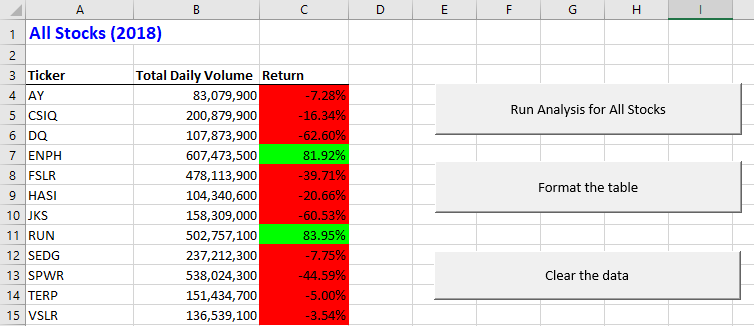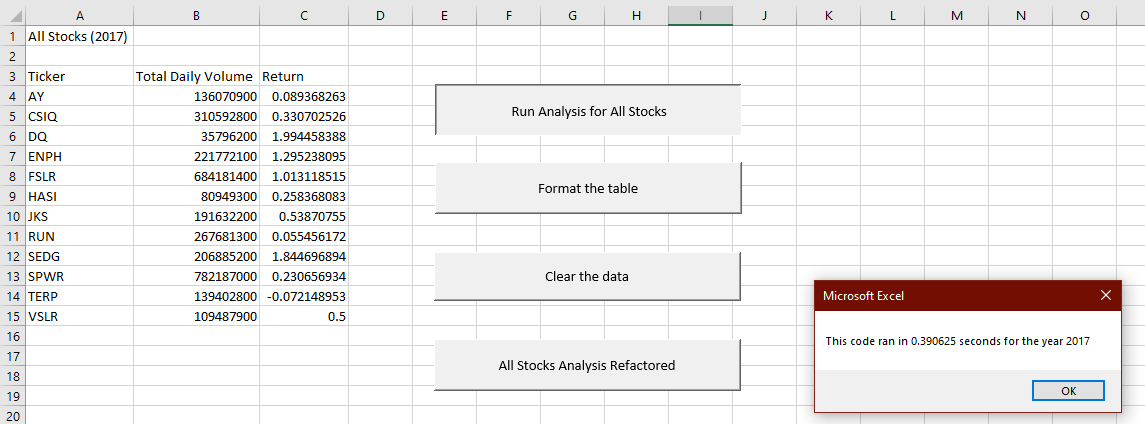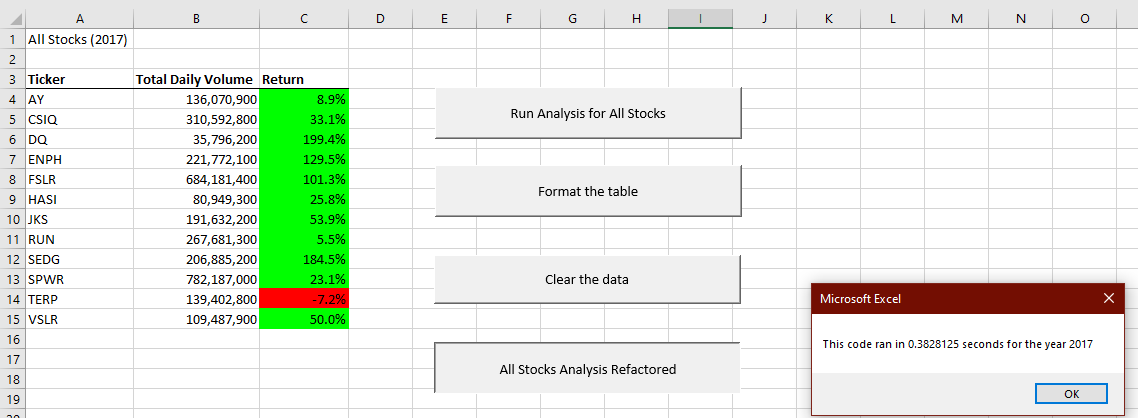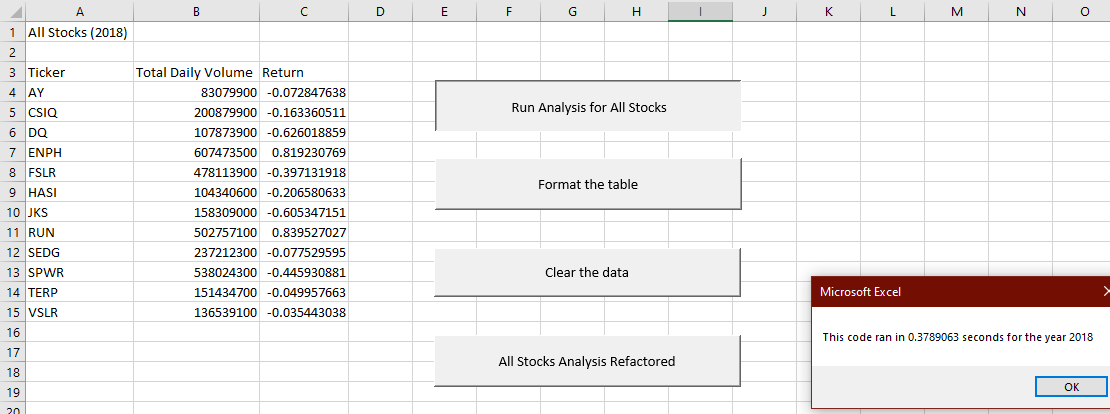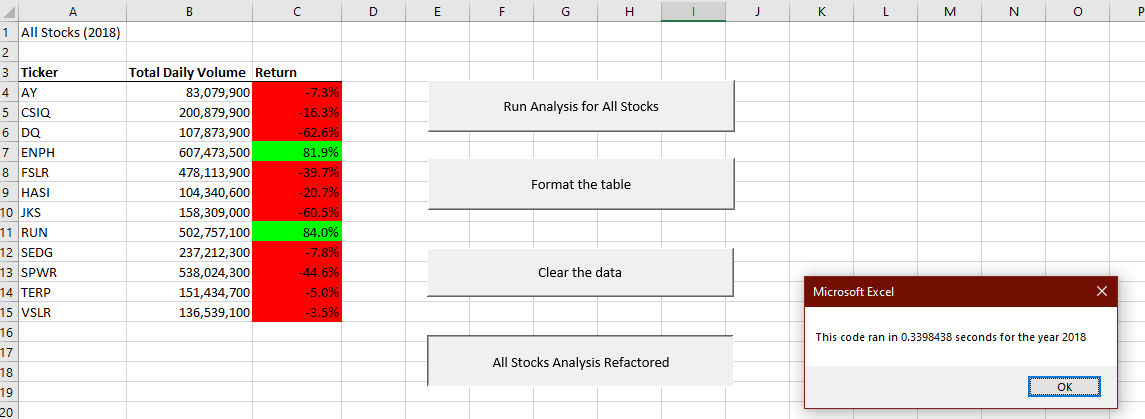This project is created to analyze green energy stocks, particularly DAQO New Energy Corp (DQ), and determine the most efficient ones based on their performance (amount sold and return) for diversification of investment funds using Excel and VBA.
First I calculated Total Daily Volume (amount of sold DQ stocks) and Return (difference between the stock prices at the end of the year 2018 to the beginning of the year 2018) using code:
Sub DQAnalysis()
Worksheets("DQ Analysis").Activate
Range("A1").Value = "DAQO (Ticker: DQ)"
'Create a header row
Cells(3, 1).Value = "Year"
Cells(3, 2).Value = "Total Daily Volume"
Cells(3, 3).Value = "Return"
Worksheets("2018").Activate
Dim startingPrice As Double
Dim endingPrice As Double
' Establish the number of rows to loop over
rowStart = 2
'DELETE: rowEnd = 3013
'rowEnd code taken from https://stackoverflow.com/questions/18088729/row-count-where-data-exists
rowEnd = Cells(Rows.Count, "A").End(xlUp).Row
'set initial volume to zero
totalVolume = 0
'loop over all the rows
For i = rowStart To rowEnd
If Cells(i, 1).Value = "DQ" Then
'increase totalVolume if ticker is "DQ"
totalVolume = totalVolume + Cells(i, 8).Value
End If
If Cells(i, 1).Value = "DQ" And Cells(i - 1, 1).Value <> "DQ" Then
startingPrice = Cells(i, 6).Value
End If
If Cells(i, 1).Value = "DQ" And Cells(i + 1, 1).Value <> "DQ" Then
endingPrice = Cells(i, 6).Value
End If
Next i
'MsgBox (totalVolume)
Worksheets("DQ Analysis").Activate
Cells(4, 1).Value = 2018
Cells(4, 2).Value = totalVolume
Cells(4, 3).Value = (endingPrice / startingPrice) - 1
End SubIn 2018 DQ showed the negative return -63%. That means that DQ stocks decreased in price about 63%.
To find better stocks to invest in I calculated Total Daily Volume and Return for all other stocks in 2018 and 2017 using code:
Sub AllStocksAnalysis()
Dim startTime As Single
Dim endTime As Single
Worksheets("All Stocks Analysis").Activate
Dim yearValue As String
yearValue = InputBox("What year would you like to run the analysis on?")
startTime = Timer
Range("A1").Value = "All Stocks (" + yearValue + ")"
'Create a header row
Cells(3, 1).Value = "Ticker"
Cells(3, 2).Value = "Total Daily Volume"
Cells(3, 3).Value = "Return"
'2) Initialize array of all tickers
Dim tickers(11) As String
tickers(0) = "AY"
tickers(1) = "CSIQ"
tickers(2) = "DQ"
tickers(3) = "ENPH"
tickers(4) = "FSLR"
tickers(5) = "HASI"
tickers(6) = "JKS"
tickers(7) = "RUN"
tickers(8) = "SEDG"
tickers(9) = "SPWR"
tickers(10) = "TERP"
tickers(11) = "VSLR"
'3a) Initialize variables for starting price and ending price
Dim startingPrice As Double
Dim endingPrice As Double
'3b) Activate data worksheet
Sheets(yearValue).Activate
'3c) Get the number of rows to loop over
RowCount = Cells(Rows.Count, "A").End(xlUp).Row
'4) Loop through tickers
For i = 0 To 11
ticker = tickers(i)
totalVolume = 0
'5) loop through rows in the data
Worksheets(yearValue).Activate
For j = 2 To RowCount
'5a) Get total volume for current ticker
If Cells(j, 1).Value = ticker Then
'increase totalVolume
totalVolume = totalVolume + Cells(j, 8).Value
End If
'5b) get starting price for current ticker
If Cells(j, 1).Value = ticker And Cells(j - 1, 1).Value <> ticker Then
startingPrice = Cells(j, 6).Value
End If
'5c) get ending price for current ticker
If Cells(j, 1).Value = ticker And Cells(j + 1, 1).Value <> ticker Then
endingPrice = Cells(j, 6).Value
End If
Next j
'6) Output data for current ticker
Worksheets("All Stocks Analysis").Activate
Cells(4 + i, 1).Value = ticker
Cells(4 + i, 2).Value = totalVolume
Cells(4 + i, 3).Value = (endingPrice / startingPrice) - 1
Next i
endTime = Timer
MsgBox ("This code ran in " & (endTime - startTime) & " seconds for the year " & (yearValue))
End SubI also added buttons and formatted the table to make it easier to understand for users using code:
Sub ClearWorksheet()
Cells.Clear
End Subfor "Clear the table" button and code:
Sub formatAllStocksAnalysisTable()
Worksheets("All Stocks Analysis").Activate
Range("A3:C3").Font.Bold = True
Range("A3:C3").Borders(xlEdgeBottom).LineStyle = xlContinuous
Range("A1").Font.Size = 14
Range("A1").Font.Color = vbBlue
Range("A1").Font.Bold = True
Range("B4:B15").NumberFormat = "#,##0"
Range("C4:C15").NumberFormat = "0.00%"
Columns("B").AutoFit
dataRowStart = 4
dataRowEnd = 15
For i = dataRowStart To dataRowEnd
If Cells(i, 3) > 0 Then
'Color the cell green
Cells(i, 3).Interior.Color = vbGreen
ElseIf Cells(i, 3) < 0 Then
'Color the cell red
Cells(i, 3).Interior.Color = vbRed
Else
'Clear the cell color
Cells(i, 3).Interior.Color = xlNone
End If
Next i
End Subfor "Format the table " button.
As a result of this analysis we can see that only two of twelve stocks showed positive dynamics in 2018: "ENPH" and "RUN":
2017 though was a pretty successful year for almost all the stocks including "DQ":
Stocks "ENPH" show good results for two years in a row what makes them attractive to invest in. "RUN" increased in price in 2017 less than others did but the dynamics is still positive. "DQ" raised well in 2017 (by almost 200%) but dropped in 2018 by 63%.
If calculate the approximate two-years-term outcome we get
(x+2x) -- (x+2x)*0.63 = 3x -- 1.89x = 1.11x
what means that "DQ" stocks raised by 11% - still positive result but pretty risky.
This script works well for twelve stocks but might be a little slow for a bigger amount of stocks because it performs all the operations (activation the right worksheet, calculations and output) inside of one for-loop. To make it work faster we can separate parts that can work independently and don't need to be repeated for every step of the for-loop like
- Making tikerVolume = 0 for every ticker
- Activation the right worksheet
- Output the values into All Stocks Analysis worksheet using new arrays (tickerVolumes(), tickerStartingPrice() and tickerEndingPrice()).
After doing all these steps and adding the formatting part into the code I got:
Sub AllStocksAnalysisRefactored()
Dim startTime As Single
Dim endTime As Single
Dim yearValue As String
Dim ticker As String
yearValue = InputBox("What year would you like to run the analysis on?")
startTime = Timer
'Format the output sheet on All Stocks Analysis worksheet
Worksheets("All Stocks Analysis").Activate
Range("A1").Value = "All Stocks (" + yearValue + ")"
'Create a header row
Cells(3, 1).Value = "Ticker"
Cells(3, 2).Value = "Total Daily Volume"
Cells(3, 3).Value = "Return"
'Initialize array of all tickers
Dim tickers(12) As String
tickers(0) = "AY"
tickers(1) = "CSIQ"
tickers(2) = "DQ"
tickers(3) = "ENPH"
tickers(4) = "FSLR"
tickers(5) = "HASI"
tickers(6) = "JKS"
tickers(7) = "RUN"
tickers(8) = "SEDG"
tickers(9) = "SPWR"
tickers(10) = "TERP"
tickers(11) = "VSLR"
'Activate data worksheet
Worksheets(yearValue).Activate
'Get the number of rows to loop over
RowCount = Cells(Rows.Count, "A").End(xlUp).Row
'1a) Create a ticker Index
Dim tickerIndex As Integer
tickerIndex = 0
'1b) Create three output arrays
Dim tickerVolumes(12) As Long
Dim tickerStartingPrices(12) As Single
Dim tickerEndingPrices(12) As Single
''2a) Create a for loop to initialize the tickerVolumes to zero.
For tickerIndex = 0 To 11
tickerVolumes(tickerIndex) = 0
Next tickerIndex
For tickerIndex = 0 To 11
ticker = tickers(tickerIndex)
''2b) Loop over all the rows in the spreadsheet.
Worksheets(yearValue).Activate
For i = 2 To RowCount
If Cells(i, 1).Value = ticker Then
'3a) Increase volume for current ticker
tickerVolumes(tickerIndex) = tickerVolumes(tickerIndex) + Cells(i, 8).Value
End If
'3b) Check if the current row is the first row with the selected tickerIndex.
'If Then
If Cells(i, 1).Value = ticker And Cells(i - 1, 1).Value <> ticker Then
tickerStartingPrices(tickerIndex) = Cells(i, 6).Value
'End If
End If
'3c) check if the current row is the last row with the selected ticker
If Cells(i, 1).Value = ticker And Cells(i + 1, 1).Value <> ticker Then
tickerEndingPrices(tickerIndex) = Cells(i, 6).Value
End If
'If the next row’s ticker doesn’t match, increase the tickerIndex.
'If Then
'DELETE If Cells(i, 1).Value = ticker And Cells(i + 1, 1).Value <> ticker Then
'3d Increase the tickerIndex.
'DELETE tickerIndex = tickerIndex + 1
'End If
'DELETE End If Othewise it doesn't work
Next i
Next tickerIndex
'4) Loop through your arrays to output the Ticker, Total Daily Volume, and Return.
For i = 0 To 11
Worksheets("All Stocks Analysis").Activate
Cells(4 + i, 1).Value = tickers(i)
Cells(4 + i, 2).Value = tickerVolumes(i)
Cells(4 + i, 3).Value = (tickerEndingPrices(i) / tickerStartingPrices(i)) - 1
Next i
'Formatting
Worksheets("All Stocks Analysis").Activate
Range("A3:C3").Font.FontStyle = "Bold"
Range("A3:C3").Borders(xlEdgeBottom).LineStyle = xlContinuous
Range("B4:B15").NumberFormat = "#,##0"
Range("C4:C15").NumberFormat = "0.0%"
Columns("B").AutoFit
dataRowStart = 4
dataRowEnd = 15
For i = dataRowStart To dataRowEnd
If Cells(i, 3) > 0 Then
Cells(i, 3).Interior.Color = vbGreen
Else
Cells(i, 3).Interior.Color = vbRed
End If
Next i
endTime = Timer
MsgBox "This code ran in " & (endTime - startTime) & " seconds for the year " & (yearValue)
End SubLet's compare the execution time of these two codes.
For 2017 year
Original code:
Refactored one:
Even though in second code we calculated the time needed to make all the calculations and formatting it is still 0.01 seconds less than for executing first one for just calculations.
Same for the 2018 year:
Original code:
Refactored one:
Again the refactored code is 0.04 seconds faster than original one.
-
It makes the calculations faster
-
The code is less logically complex, easier to understand
-
Less steps are taken to get results
-
Less memory is used
-
Simplifies support and code updates
-
Saves time and money in future
-
Maintainability and scalability
-
Finding hidden bugs and fixing them.
- Refactoring is time-consuming.
- Made the code work faster
- The code looks less complex, easier to understand
- Less steps are taken to get results.
- Refactoring is time-consuming
- Had to create new and rename some old variables and arrays which can be confusing.

